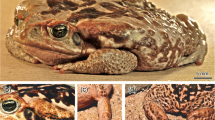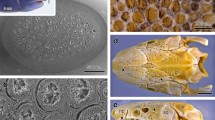Summary
The aim of this project was to see whether 5-hydroxytryptamine (5-HT) believed to be present in the skin glands of anuran amphibians can be demonstrated histochemically. The Periodic acid-Schiff technique (P.A.S.) and three histochemical methods known to demonstrate 5-HT in enterochromaffin cells (Pontana's, diazonium and Schmorl's) were applied to the dorsal skin of three species—Xenopus laevis, Rana angolensis and Bufo regularis.
Mucous glands were identified by their P.A.S. reactivity in all three species. Poison glands were identifiable in Bufo regularis and Xenopus laevis only. The secretory granules of the latter glands have strong positive reactions with all three histochemical techniques used.
It is concluded that the poison glands of anuran amphibians contain 5-HT demonstrable by histochemical means.
Similar content being viewed by others
Bibliography
Benditt, E. P., Wong, R. L.: On the concentration of 5-hydroxytryptamine in mammalian enterochromaffin cells and its release by reserpine. J. exp. Med. 105, 509–520 (1957).
Erspamer, V.: Quantitative estimation of 5-hydroxytryptamine in gastrointestinal mucosa, spleen and blood of vertebrates. In Ciba foundation symposium on hypertension. London: Churchill 1954.
— Asero, B.: Identification of enteramine, the specific hormone of the enterochromaffin system, as 5-hydroxytryptamine. Nature (Lond.) 169, 800–801 (1952).
Ferguson, M. M., McGadey, J.: Steroid utilization by amphibian skin. Histochemie 22, 36–38 (1970).
Helff, O. M., Stark, W.: Studies on amphibian metamorphosis. J. Morph. 68-69, 303–324 (1941).
Pearse, A. G. E.: Histochemistry, 3rd ed. London: Churchill 1960.
Turner, C. D.: In: General endocrinology, p. 167. Philadelphia: W. B. Saunders Co. 1966.
Vanable, J. W.: Granular gland development during Xenopus laevis metamorphosis. Develop. Biol. 10, 331–355 (1964).
Veerdonk, F. C. G. van de: Serotonin, a melanocyte-stimulating component in the dorsal skin secretion of Xenopus laevis. Nature (Lond.) 187, 948–949 (1960).
Author information
Authors and Affiliations
Rights and permissions
About this article
Cite this article
Kramer, B. Histochemical demonstration of 5-hydroxytryptamine in poison glands of amphibian skin. Histochemie 24, 336–342 (1970). https://doi.org/10.1007/BF00278219
Received:
Issue Date:
DOI: https://doi.org/10.1007/BF00278219




